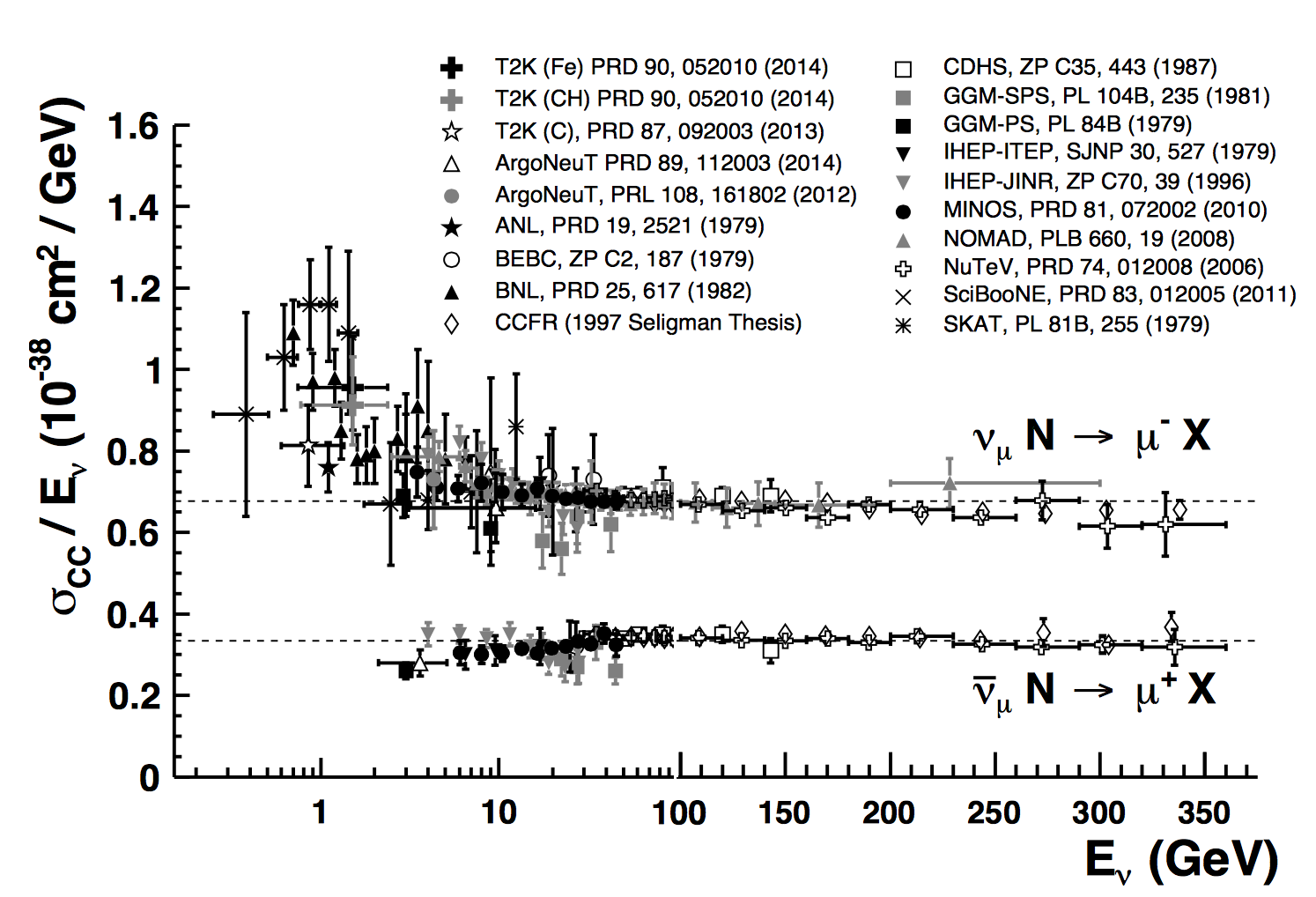Introduction to Neutrino Interactions
Imagining that you’re designing a neutrino experiment to measure neutrino oscillations or looking for some other exciting neutrino physics, you need to estimate how many neutrino interactions you expect to see and what will they look like. The number of neutrino you expect in detector is proportional to the neutrino flux, cross section of neutrino interaction and number of target (protons, neutrons) in your detector
N𝜈(E) ~ ɸ𝜈(E) x σ𝜈(E) x target
Thus you need to know neutrino cross section to estimate the number of neutrino interactions you expect in your detector. Also, it would tell you what you should observe in the detector (note that you can’t observe neutrino directly, but detect products of their interaction.) At current stage, understanding neutrino interactions with matter plays an important role in reducing impact of systematic effects on the neutrino oscillation measurement, especially when we are stepping into the precision era and exploring CP violation, mass hierarchy. Despite the majority of interest stemming from its effect on neutrino oscillations, neutrino interactions are interesting in and of themselves.
If gravity doesn’t take into account because of neutrino’s small mass, neutrinos interact only via the weak force. Thus the interaction cross sections are much smaller than those of other particle species. For example, the cross section of ν ̄ + p → e+ + n is about 5x10-44 cm2 while the cross section for the corresponding electromagnetic process with a photon is about 10-25 cm2.
Basically we have two types of neutrino interactions: charged-current (CC) and neutral-current (NC). The former is when neutrino exchange W+/- with nucleons while the latter is when neutrino exchange Z with nucleons. There is another way to classify the neutrino interactions based on the final state of nucleon. If the final state of nucleon doesn’t change after neutrino scattering, we call it “elastic”. If the final state change, we call it “inelastic”. In the case of charged-current, we have “quasi-elastic” interaction when the nucleon changes but not break up.
𝜈μ + n →μ- + p 𝜈e + n →e- + p (quasi-elastic scattering)
The neutrino-nucleus interactions can be separated into three energy region: low, intermediate and high energy. At low energy O(MeV) (interest to solar and reactor neutrino experiments), the interaction length is greater than the nuclear diameter. Thus the initial and final states are specific nuclear levels. In the intermediate energy O(1.GeV) (interest to atmospheric and accelerator-based neutrino experiment), the interaction length is around 1fm and the nuclear effect becomes important. At high energy O(100 GeV), the interaction length is ~0.1fm and thus nuclear effects are depressed. We will focus on the neutrino-nucleus interaction in intermediate energy.
In most of neutrino experiment, the target is nuclei and we need to model neutrino-nuclei interactions. In the simplest sense, this model needs a combination of neutrino-nucleon scattering and a model for nucleons in the nuclei. In the simplest picture, neutrino-nuclei interaction can be treated as the incoherent sum of interaction from free nucleons. However in reality, the nucleons in the nuclei have some initial momentum which would modified the kinematics of interaction products. Furthermore, kinematics of interaction product might be altered when they get out of nucleus after initial interacting with nucleon.

Interesting channels to keep eyes on:
- 𝜈e and 𝜈-e scattering
- Neutrino interaction in water (relevant to T2K, Hyper-K)
- MEC (2p-2h)
- Coherent Pion production
- NC gamma
Read more about Neutrino Interactions:
- Follow NuINT workshop series which aims for tracking activities in this field
- Ulrich Mosel: Neutrino Interactions with Nucleon and Nuclei: Important for Long-baseline Experiment
- H. Gallagher, G. Garvey, G. Zeller: Neutrino-nucleus interactions
- Kelvin Mc. Farland: Neutrino Interactions
- http://cupp.oulu.fi/neutrino//nd-cross.html
Go to >>>Neutrino Oscillations
Go to >>>CP violation search
Go to >>>Sterile neutrino seach
------------------------------------
The "neutrino cross-section newsletter" discusses the latest interesting neutrino cross result, either experiment or theory, roughly every other week. This mailing list is also used for various announcements related with neutrino interaction physics.
To unsubscribe
- Send an e-mail to listserv@fnal.gov
- Leave the subject line blank
- Type "unsubscribe nustec-news" (without the quotation marks) in the body
To subscribe
- Send an e-mail to listserv@fnal.gov
- Leave the subject line blank
- Type "subscribe nustec-news firstname lastname"
©nuGroup, ICISE 2016